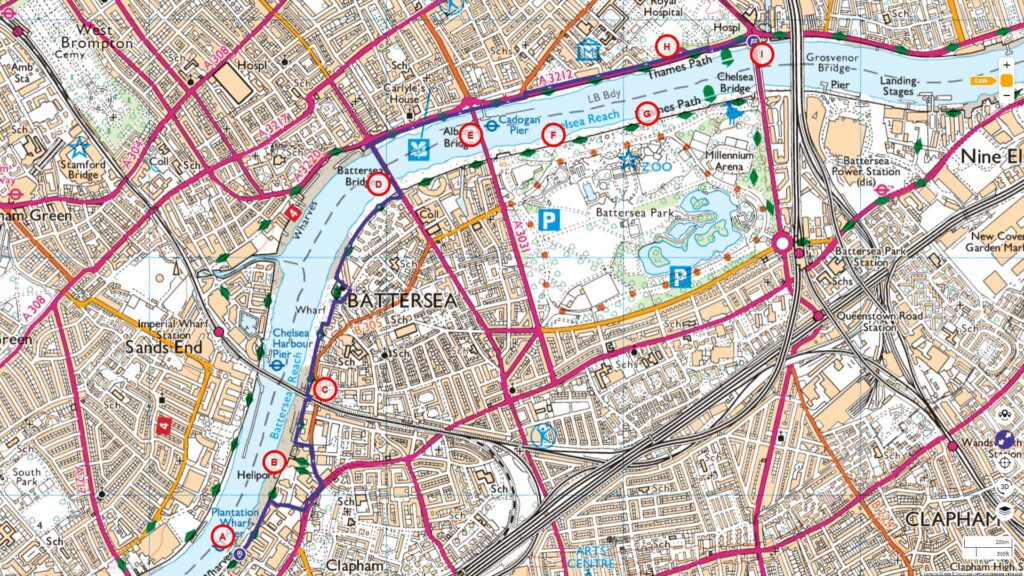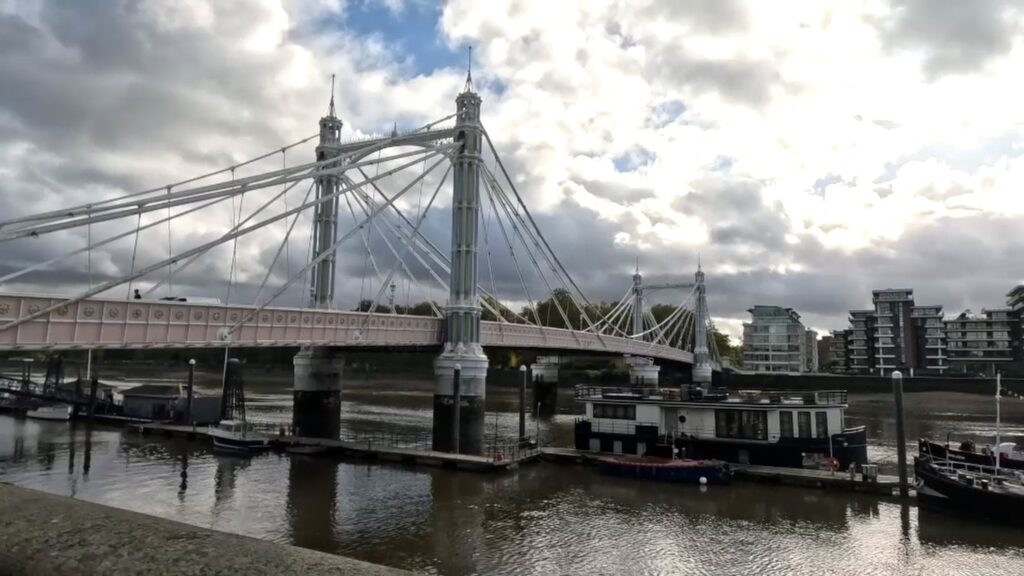This short walk on the Thames Path from Plantation Wharf to Chelsea Bridge passed landmarks like the Albert Bridge and Battersea Park to illustrate the city’s evolution from industrial hub to residential destination.
Follow the entire walk on . The route map is available on

B: Heliport
C: Battersea Railway Bridge
D: Battersea Bridge
E: Albert Bridge
F: Battersea Park
G: Pagoda
H: Royal Hospital
I: Chelsea Bridge
Embarking on this historical stretch along the Thames, one begins at the rejuvenated [A] Plantation Pier and concludes at the iconic [I] Chelsea Bridge, experiencing London’s rich tapestry woven along the river’s edge.
Our journey commences at the [A] Plantation Wharf, where what was once a bustling industrial hub along the River Thames has been transformed into a modern residential haven. The transition from a 19th-century wharf to a 21st-century complex is reflective of London’s continual evolution.
Advancing a mere 300 meters, we encounter the [B] London Heliport, an aviation landmark since 1959. It stands as a testament to London’s post-war industrial ambition and now serves as a base for helicopters that stitch the modern city’s skyline together. The heliport’s unique history can be further explored at Learn More.
Next, the path curves around the heliport leading to the [C] Battersea Railway Bridge. Since 1863, this bridge has carried countless commuters and now represents a steadfast link in London’s sprawling rail network.
A 0.6 km stroll takes us to the [D] Battersea Bridge, where history and modernity collide. Sir Joseph Bazalgette’s architectural vision has withstood the ravages of time and war, offering panoramic views that command one’s gaze both up and down the Thames.
Continuing on, the walk brings us to the [E] Albert Bridge, a true eccentric among London’s crossings. A blend of engineering styles and a history peppered with anecdotes render the bridge not only a vital conduit but also a beloved landmark. Further details of its colorful past are found at Learn More.
After crossing [E] Albert Bridge, the pathway opens up to the grand vista of [F] Battersea Park, an urban sanctuary sprawling over 200 acres. The park’s Peace Pagoda punctuates the skyline, while the historical vignette of Cadogan Pier whispers tales of the past. The park’s serene presence is noted alongside the urban pulse of Chelsea Embankment. Discover more about the park at Learn More.
Navigating eastward, the journey ushers you towards the [G] Pagoda, silently observing the passersby from its stoic presence amidst the trees.
As the path diverts due to ongoing construction, a detour leads to the [H] Royal Hospital Chelsea. This institution continues its noble legacy of caring for British army veterans, a narrative that has unfolded since its inception in 1682. Explore this living history at Learn More.
The culmination of this segment is marked by the [I] Chelsea Bridge, connecting not only the banks of the Thames but also linking historical epochs—from Roman incursions to modern-day urban tales. Its evolution from a toll bridge to a free passage mirrors the city’s own journey towards inclusivity and accessibility. The bridge’s multifaceted history can be uncovered at Learn More.
Thank you for accompanying us on this historical promenade. Another article will continue the exploration from the [I] Chelsea Bridge, promising more stories woven into the fabric of London. Subscribe to our Youtube channel to stay informed on this ongoing journey.

